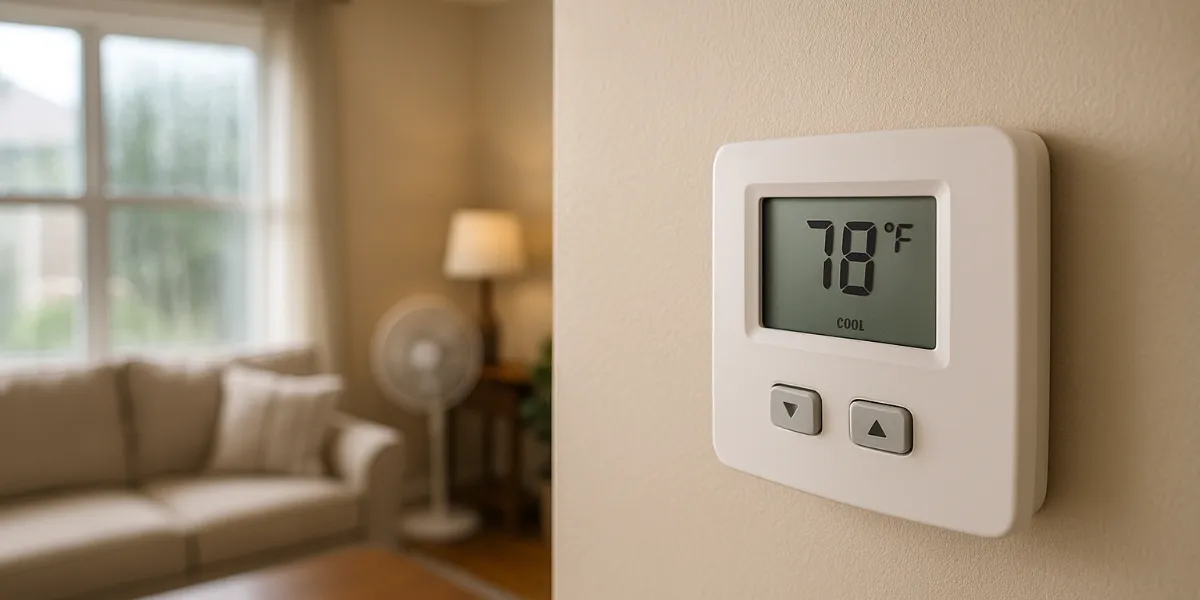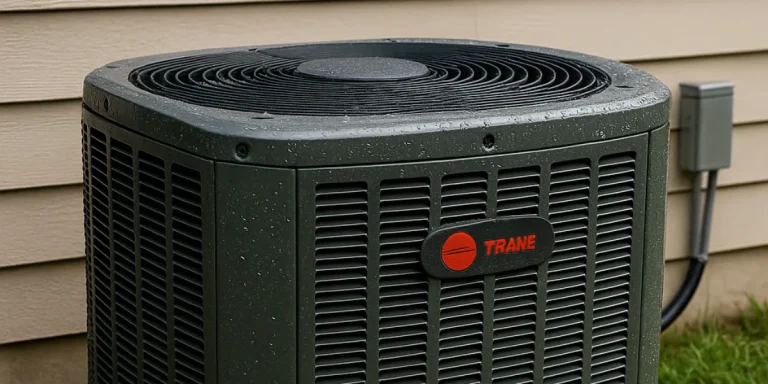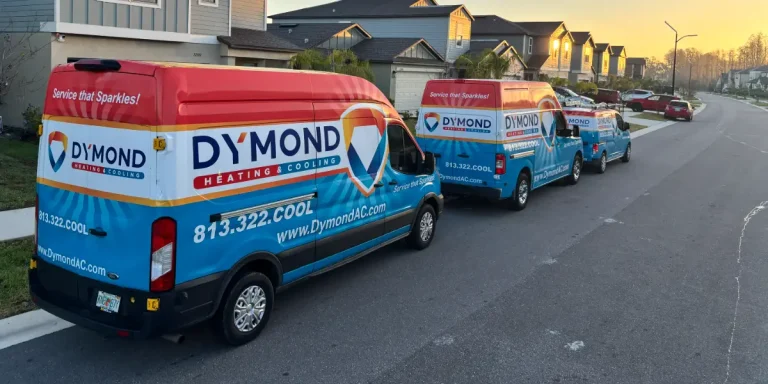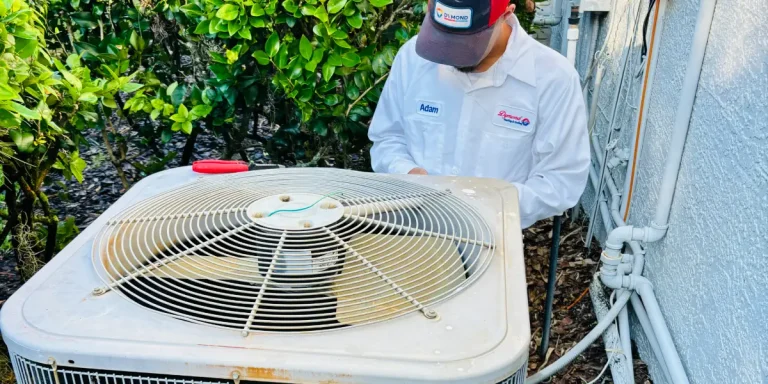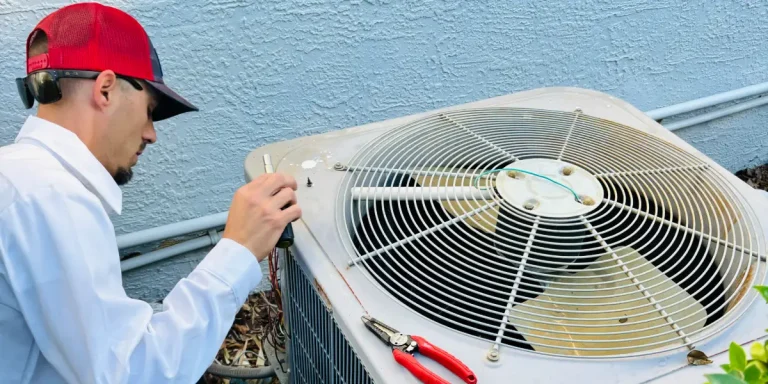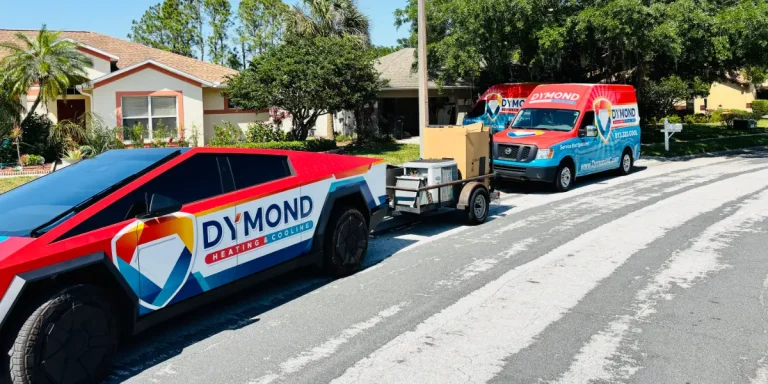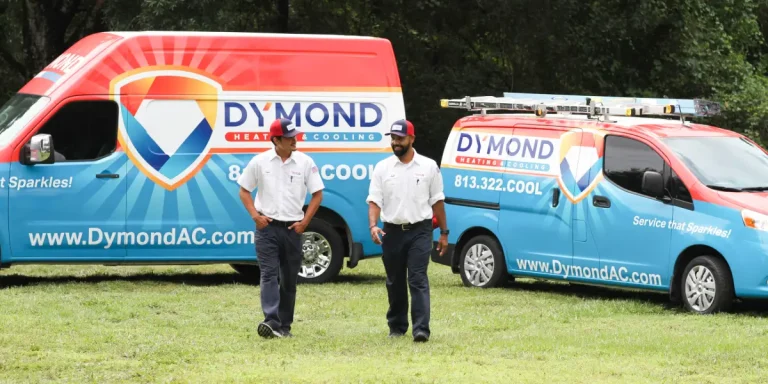How to Tell If Your AC Thermostat Is Malfunctioning
When your home isn’t cooling the way it should, many homeowners immediately assume there’s an issue with their air conditioner. But in many cases, the real problem lies with the thermostat—the small but essential device that tells your HVAC system when to run, for how long, and how hard.
At Dymond Heating & Cooling, we often get calls from frustrated homeowners in Pasco County who think they need a major AC repair—only to discover that a simple thermostat issue is the culprit. In this post, we’ll explain how to recognize a malfunctioning thermostat, what causes it, and when to call a professional.
Why your thermostat matters
Your thermostat is one of the smallest components of your HVAC system—but it plays one of the most critical roles. It acts as the communication hub between you and your heating and cooling equipment. When working correctly, it constantly monitors the indoor temperature and tells your air conditioner, heat pump, or furnace when to turn on or off to keep your home at the temperature you set.
However, when your thermostat isn’t functioning properly, it throws off the entire system. Even if your HVAC equipment is in perfect condition, a faulty thermostat can cause:
-
- Short cycling – The system starts and stops rapidly, never completing a full cooling or heating cycle
- Uneven comfort – Some areas of your home may be too hot or too cold while others stay neutral
- Overuse of energy – If your thermostat isn’t accurately reading the temperature, it may cause your system to run longer than needed
- Unresponsive system behavior – Your system may ignore thermostat settings entirely or shut down unexpectedly
These issues not only make your home uncomfortable, but they also increase energy usage and strain on your HVAC components. That can lead to premature wear, breakdowns, and unnecessary service calls.
A properly functioning thermostat helps your system run smoothly, keeps your utility bills in check, and ensures consistent indoor comfort—especially important in Florida’s hot, humid climate. At Dymond Heating & Cooling, we help homeowners across Pasco County identify thermostat issues early, avoiding bigger HVAC problems down the line. Whether you need a quick fix, a recalibration, or a full thermostat replacement, we’ve got you covered.
Signs your thermostat might be malfunctioning
A faulty thermostat can cause a range of frustrating issues—but the symptoms aren’t always obvious at first. Many Florida homeowners assume their AC is failing when, in reality, the thermostat is the real problem. Knowing what to look for can help you catch the issue early and avoid unnecessary stress, discomfort, or system damage.
Here are the most common signs your thermostat might not be working correctly:
1. Inconsistent room temperatures
If certain rooms in your home feel much warmer or cooler than others—despite the AC running—your thermostat may not be accurately reading the indoor temperature. In multi-zone homes, this can lead to uneven cooling and poor comfort control.
This issue often comes from:
-
-
- Faulty sensors within the thermostat
- Poor thermostat placement (e.g., near a window or vent)
- Calibration issues causing incorrect temperature readings
-
In many cases, a professional recalibration or thermostat replacement can restore even, efficient cooling throughout your home.
2. AC won’t turn on or off
When your thermostat stops communicating with your HVAC system, your AC may:
-
-
- Fail to start, leaving your home hot and humid
- Run constantly, even after reaching the desired temperature
-
Both situations can indicate a wiring issue, a faulty internal component, or a short in the control board. It’s important to address this quickly, as it can waste energy and cause long-term wear on your system.
Dymond Heating & Cooling can diagnose control-related issues and make sure your thermostat is properly connected to your AC unit, heat pump, or zoned cooling system.
3. Blank or unresponsive display
If your thermostat’s screen is blank, frozen, or unresponsive, it may not be sending signals to your HVAC system at all. While this could be as simple as dead batteries or a tripped breaker, it can also point to:
-
-
- Faulty wiring
- Power loss to the thermostat
- Software glitches or internal failure in smart models
-
If replacing the batteries and resetting the unit doesn’t help, it’s best to have the system inspected by a licensed technician.
4. Short cycling
Short cycling occurs when your AC turns on and off in rapid bursts, never completing a full cooling cycle. This not only reduces your comfort—it puts serious strain on your system.
Common causes include:
-
-
- Thermostat misreading the actual room temperature
- Faulty sensors sending mixed signals to your HVAC equipment
- Oversized AC units being controlled by outdated or mismatched thermostats
-
If you notice your system turning on and off frequently (especially in under 10 minutes), contact Dymond Heating & Cooling. We’ll determine whether it’s a thermostat issue or a larger mechanical problem.
5. Temperature doesn’t match the setting
When your home feels significantly warmer or cooler than the set temperature, your thermostat may be miscalibrated. For example, if it's set to 72°F but consistently reads 78°F, something isn't right.
This can happen due to:
-
-
- Sensor drift from age or manufacturing defects
- Poor placement affecting temperature readings
- Heat buildup around the unit (e.g., from electronics or direct sunlight)
-
An inaccurate thermostat disrupts the balance of your entire system. Fortunately, our team can recalibrate or upgrade your thermostat to ensure accurate readings and consistent comfort in every room.
Spotting these signs early allows you to avoid larger HVAC problems—and with help from Dymond Heating & Cooling, you can quickly restore control over your indoor comfort. Whether you need a simple fix or a complete smart thermostat installation, we’re here to help.
What causes thermostat issues?
Thermostat problems can sneak up on homeowners, especially when the rest of the HVAC system seems to be running fine. Because the thermostat serves as the brain of your heating and cooling operation, even small malfunctions can lead to big comfort and efficiency issues. Understanding the root causes of thermostat failures can help you spot trouble early and avoid unnecessary system strain.
Here are the most common reasons thermostats begin to fail or behave unpredictably:
Old or outdated thermostat models
If your thermostat is more than 10–15 years old, it may no longer provide accurate temperature control. Older analog models tend to wear out over time and often lack the precision or programmability of modern digital or smart thermostats.
Symptoms of outdated thermostats include:
-
- Inaccurate temperature readings
- Limited control options
- No energy-saving features
- Compatibility issues with newer HVAC systems
Upgrading to a smart thermostat not only resolves these issues but can also improve efficiency, reduce energy bills, and give you greater control over your indoor climate—especially in Florida’s variable weather.
Improper installation or wiring issues
Thermostats are sensitive instruments, and even minor mistakes during installation can create long-term problems. If wires are:
-
- Loosely connected
- Crossed or mislabeled
- Not grounded properly
…the thermostat may fail to communicate reliably with your AC system, heat pump, or zoned controls. These errors can cause frequent short cycling, inconsistent comfort, or complete system failures.
At Dymond Heating & Cooling, we ensure your thermostat is installed correctly, with all wiring checked for safety, durability, and compliance with local codes.
Power problems
Many thermostat malfunctions can be traced back to simple power issues. These include:
-
- Dead or weak batteries (in battery-powered models)
- Tripped breakers affecting low-voltage wiring
- Power surges or lightning strikes that damage internal components
A thermostat without consistent power may display a blank screen, reboot repeatedly, or become unresponsive altogether. Our team will inspect both the thermostat and the power supply to ensure reliable, uninterrupted operation.
Poor thermostat placement
Location matters more than most homeowners realize. If your thermostat is placed in the wrong part of the home, it can give false readings and confuse your HVAC system.
Problematic thermostat placements include:
-
- Near windows or direct sunlight, which can cause overheating and early shutoff
- Close to vents or appliances, where cold or hot air disrupts temperature sensing
- In drafty hallways or rarely used rooms, which don’t reflect true household conditions
We evaluate each thermostat’s location and recommend optimal placement for accurate control and balanced comfort across your home.
At Dymond Heating & Cooling, we go beyond a quick fix—we inspect your entire control system, including wiring, calibration, location, and compatibility. Whether you’re dealing with a glitchy thermostat or a larger comfort concern, we provide expert solutions to restore reliability, comfort, and efficiency in your Florida home.
DIY tips before calling a professional
Before assuming your thermostat is broken, try these steps:
-
- Change the batteries – If it’s a battery-powered unit, low power may be the issue.
- Reset the thermostat – Power cycling can sometimes fix software glitches.
- Check circuit breakers – A tripped breaker may prevent your thermostat or HVAC system from powering on.
- Make sure it’s level – Some older thermostats need to be level on the wall to read properly.
- Clean the inside – Gently clean dust from the internal components, especially on older mechanical units.
If none of these fix the issue—or you’re not comfortable doing them—call Dymond Heating & Cooling. We’ll test your thermostat, assess your system, and provide a long-term solution.
When it’s time for a replacement
If your thermostat is more than 10 years old or repeatedly causes issues, it may be time for an upgrade. We offer a range of options, from simple digital models to smart thermostats that you can control from your phone.
Benefits of a smart thermostat include:
-
- Remote control from your smartphone or tablet
- Learning routines to automatically adjust for comfort and energy savings
- Detailed usage reports and scheduling features
- Compatibility with most HVAC systems, including heat pumps and ductless mini-splits
Our team at Dymond Heating & Cooling can recommend and install the right thermostat for your home and make sure it’s integrated with your existing system for maximum performance.
Proudly serving homes across Pasco and beyond
We provide expert thermostat diagnostics, AC repairs, system tune-ups, and smart thermostat installations throughout:
If your cooling system isn’t performing like it should, we’ll find the real cause—whether it’s your AC unit, ductwork, or the thermostat on your wall.
Restore comfort with a thermostat you can trust
Don’t ignore the signs of a failing thermostat. A small issue can lead to big problems if left unchecked—but with expert help from Dymond Heating & Cooling, you can get back to reliable, comfortable cooling fast.
Call us today or schedule your service online for a thermostat inspection or AC repair. We proudly serve homeowners across Pasco, Hillsborough, and Hernando Counties with reliable, professional HVAC solutions built for Florida’s climate.

